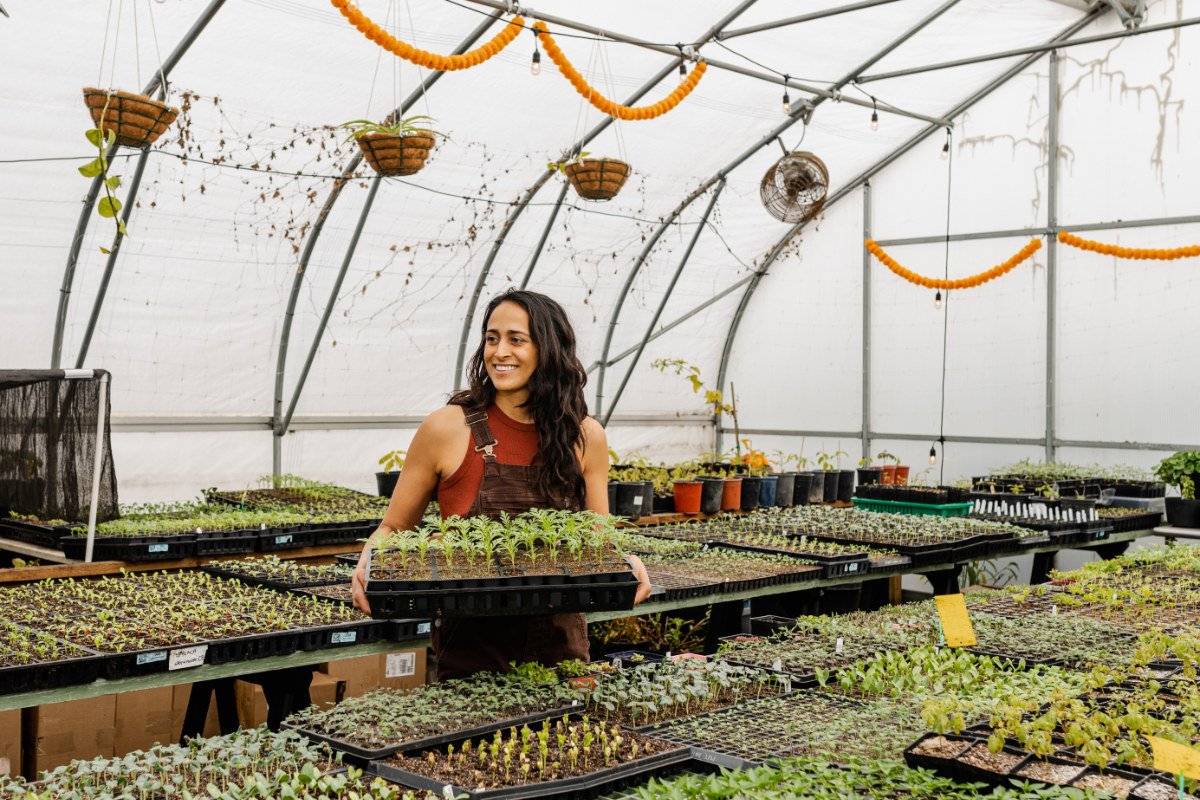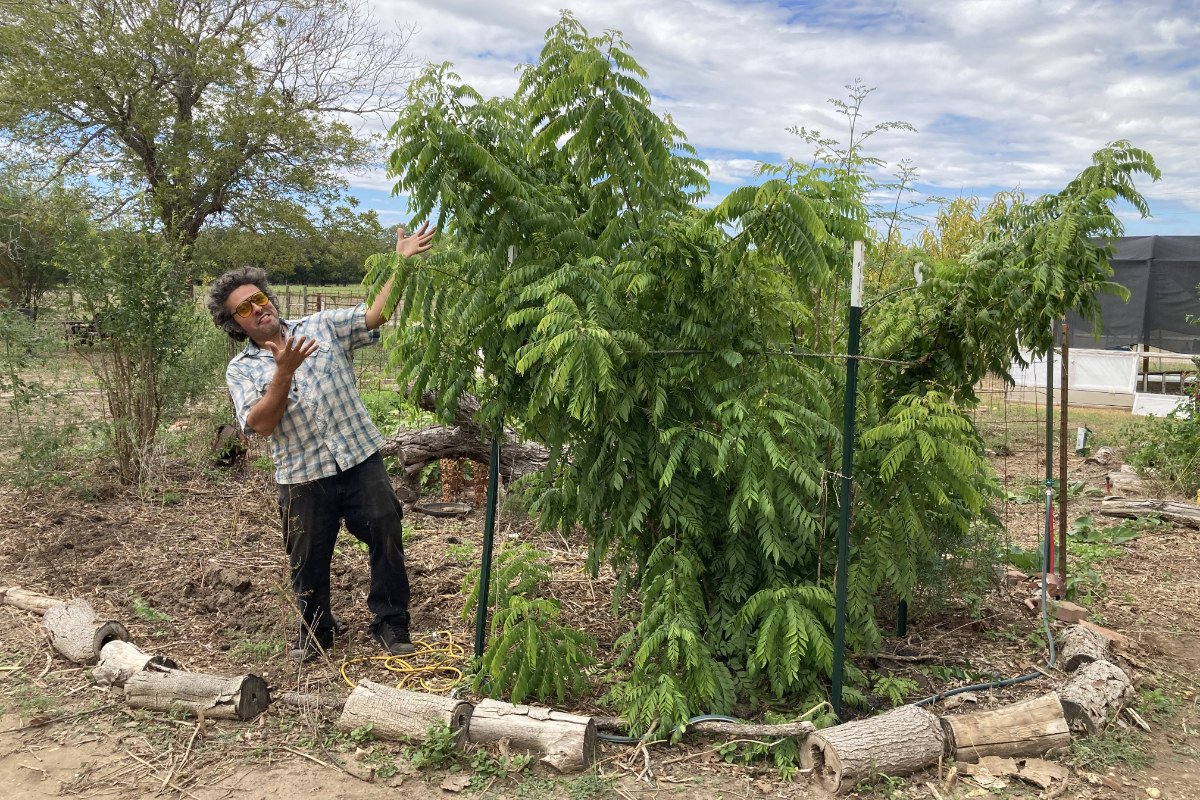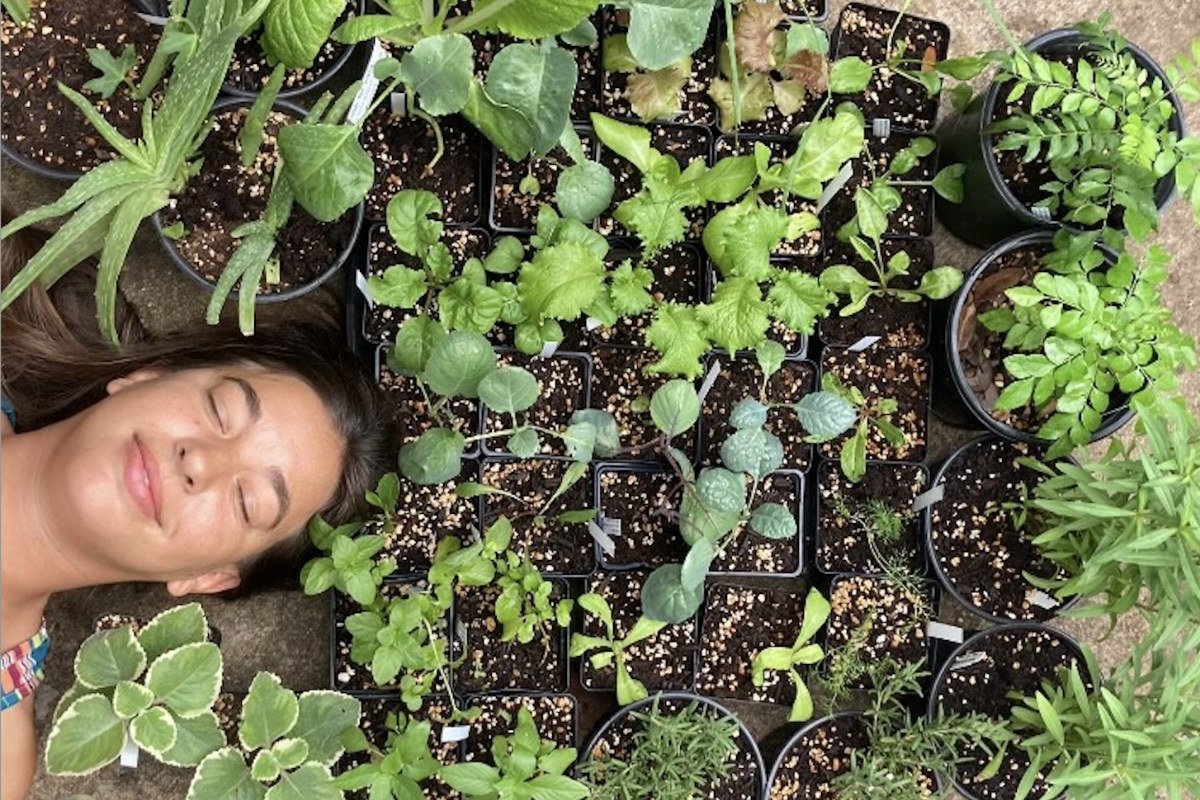Native to tropical Asia and South Asia, the curry leaf tree has managed to adapt to our climate and withstand pests, producing fresh leaves for diaspora cooks and others who love their potent flavor.

Native to tropical Asia and South Asia, the curry leaf tree has managed to adapt to our climate and withstand pests, producing fresh leaves for diaspora cooks and others who love their potent flavor.
May 8, 2024

Zee Lilani of Kula Nursery stands among her curry leaf tree starts in Oakland, California. (Photo credit: Melati Citrawireja)
When I was a child in the 1980s, my family traveled nearly every summer from our home in Los Angeles to the other side of the world. We spent monsoon-drenched weeks on my grandparents’ farm in southern India’s Kerala state.
On the last day of one of our trips, there was one final item to be packed. A housekeeper knelt under a towering 20-foot curry leaf tree and dug up one of the dozens of saplings at its base. She wrapped it in a wet towel and secured it in a plastic bag. My parents stowed it in a shoe in their suitcase, and we flew back home without encountering any inspections.
Once they transplanted the sapling into a pot, they kept it warm inside the house and watched over it carefully. But it never took to the mild, dry climate of Los Angeles, and it wilted a few weeks later. After two more saplings met the same fate, my parents gave up.
But another stowaway did make the journey successfully.
Instead of a sapling, Anand Prasad brought curry leaf seeds. He is now one of the largest commercial growers in the country, with an estimated 5,000 trees on his farm outside Los Angeles.
The idea was inspired by his grandfather, who left India with a pocketful of curry leaf seeds in the early 20th century and moved to Fiji as an indentured laborer. When his grandson Prasad emigrated from the South Pacific island to Los Angeles in 1980, he tucked several seeds into his pocket. With a lot of care, they sprouted in his new home.
“It was so hard, because those seeds were not adapted here,” Prasad said. “It’s like bringing a baby from hot weather to cold weather. But once they germinate, they start growing, and then the plants are adapted.”
He recalled covering the plant with a sheet in winter and bringing it into his house. He eventually planted it in the yard, and it grew tall. That single curry leaf tree was how his farm began.
Like other non-native plants, the curry leaf tree (Murraya koenigii), which grows in tropical parts of Asia and South Asia, has taken root, adapted, and thrived in the United States. Not to be confused with curry powder, the tree’s leaves are a staple ingredient in Indian, Sri Lankan, and other Asian cuisines. Dark green and intensely fragrant, they are roasted in hot oil to release their nutty and complex citrus flavor for curries, stews, and chutneys.
The exact date of the plant’s introduction to the U.S. is difficult to pinpoint. Now, along with the widespread availability of fresh leaves in Asian grocery stores and even on Amazon, the plant itself can be purchased for windowsill pots and kitchen gardens.
Apart from home growers, the curry leaf tree is also a burgeoning crop for a few specialty farms and nurseries scattered across warmer regions such as California, Florida, Hawaii, and Texas. As the climate changes, more regions may be suited to grow tropical plants like the curry leaf tree.
“It’s a connection to the homeland for a lot of people, and I think it really helps enrich and diversify our cultivated flora,” said David Lorence, senior research botanist at the National Tropical Botanical Garden in Kaua’i, Hawaii, which features two curry leaf trees. Lorence also has a large tree in his own yard—a necessity for his wife, of Indian origin from the island of Mauritius, and a reminder of his years there as a Peace Corps volunteer.
“It’s a connection to the homeland for a lot of people, and I think it really helps enrich and diversify our cultivated flora.”
Complicating matters, however, is the fact that the curry leaf tree is a host for the Asian citrus psyllid (ACP), an insect about the size of a flea. When insidious bacteria hitch a ride on the tiny insects, it can lead to Huanglongbing (HLB), or citrus greening disease, which affects certain members of Rutaceae, a plant family that includes oranges, lemons, and curry leaves. Citrus greening causes mottled leaves and misshapen, bitter fruit. It has no treatment or cure.
Because the pest poses significant danger to the $2.6 billion citrus industry, growers of all sizes must safeguard their trees, contending with frequent inspections, quarantine zones, and limits on the sale of fresh leaves and plants.
“The regulations are put on small-scale growers in order to protect the large industries in the United States,” said Zee Lilani, who grows 2,500 curry leaf plants at her Kula Nursery in Oakland, California.
While his lone curry leaf tree grew tall in his garden, Prasad, who is the stepfather of TV host Padma Lakshmi, worked as a general contractor for two decades. But he missed his parents’ farm in Fiji where they grew curry leaf trees.
So, in 2000, he purchased an old lemon farm 20 miles east of downtown L.A. Once he removed the dying trees, junk cars, and beer bottles strewn over the few acres, he enriched the topsoil with wood chips and planted curry leaf trees. The dark, rich mulch keeps the weeds back and water in the soil, requiring no extra fertilizer.
During my visit to the farm, Prasad walked among the estimated 5,000 plants, including large, bushy trees and countless little saplings sprouting among them. He grabbed a twig, slid off its lustrous, fragrant leaves and popped them into his mouth.
“Curry leaves have a lot of benefits,” Prasad said. “Why should I go and buy a pill if I can take care of [my health] by eating these fresh leaves?”
Prasad sells the fresh leaves wholesale at Asian grocery stores throughout Southern California and New York. And since 2020, he also dries the leaves and grinds them for Burlap & Barrel, a single-origin spice purveyor based in New York.
“Drying is difficult,” said Ethan Frisch, founder of Burlap & Barrel. “If it’s too hot, the leaves can get discolored and turn dark and also lose aromatic oils. [Prasad’s] is far and away the best dried curry leaf I’ve ever tasted, including samples we got from amazing suppliers in Sri Lanka and India.”
Those who want their own curry leaf plant can turn to friends or find one at a local store or online. Frisch purchased his now eight-inch plant from Kula Nursery.
“If you want to brag to your friends, you show them a picture of how well your tree is doing and how big it’s gotten, and that’ll get all the heads turning,” said Lilani, who began her nursery four years ago. “It’s the topic of conversation.”
Lilani grows curry leaf plants from seed and tends them in their delicate early years so buyers have a better chance of keeping them alive.
She and her family have a long history with the plant. Her grandparents are originally from India’s Gujarat state, where curry leaves are used in a few dishes, including dal. During the upheaval of Partition, when the British granted India independence and it was divided into two nations, her grandparents migrated to the newly created Pakistan. In 1991, when Lilani was a year old, she and her family moved to Los Angeles, where her grandmother grew a potted curry leaf plant in a sunny kitchen window.
Despite this early experience and, later, a master’s degree in international agriculture, Lilani finds growing curry leaf plants challenging. Last November, when hard-armor bugs infested the plants’ stems, she manually removed them from each plant with rubbing alcohol. Overwatering was another issue. She experimented with different types of soils, trying to mimic nutrient-poor soils found in tropical areas.
“Growing vegetables I can do with my eyes closed,” she said, “but the curry leaf tree has kept me on my toes for so many years.”
Since 2005, citrus greening has been detected in the southern United States, in most citrus-growing states except Arizona. The disease has devastated millions of acres of citrus crops and greatly reduced citrus production.
The U.S. Department of Agriculture (USDA) has set up quarantine areas from Florida to California to restrict the transport of citrus fruit or plants, as well as fresh curry leaves or plants.
Since 2020, Lilani has seeded and grown 2,500 curry leaf plants, but because her greenhouse is located in a quarantine zone, her customers can only buy on-site. Prasad, meanwhile, has a special USDA certification to ship outside his quarantine zone.
Besides sales restrictions, government scrutiny is another challenge for growers. Curry leaf and citrus operations are subject to inspections, according to the USDA’s Animal and Plant Health Inspection Service (APHIS). In an emailed statement, the agency said curry leaf farms and nurseries, as well as citrus groves, are surveyed for pests and diseases at least twice per year by federal, state, or cooperating agencies.

Miguel Guerra gestures at a large curry leaf tree at Small Town Farm in Texas. (Photo credit: Cristen Andrews)
APHIS also clarified that curry leaf trees are a “preferred host”—but only for Asian citrus psyllids, not the HLB bacterium that actually causes citrus greening disease. However, because detecting microscopic bacteria requires time-consuming sampling and laboratory testing, inspectors focus on finding the carrier insects.
“The best way to prevent the introduction of HLB is to prevent the introduction of ACP,” said Abby Stilwell, national policy manager at APHIS.
To stave off the disease, inspectors from the California Department of Food and Agriculture, which works in partnership with the USDA, monitored Lilani’s greenhouse in March 2021 and watched as she sprayed her saplings with two different insecticides. She repeats the spraying every three months and logs her compliance with the Alameda County Department of Agriculture.
“It’s not ideal,” said Lilani. “But it’s mandatory for me to do.”
Prasad, too, faces government checks. USDA inspectors require that he spray the trees with insecticide every month. And he said one to three inspectors visit him for about an hour every Tuesday—his shipment day—on the lookout for the dreaded ACP, which Prasad said he has never seen.
But a scare in March 2012 had devastating consequences. When a lemon-pomelo graft tested positive for citrus greening disease less than five miles from Prasad’s farm, inspectors ordered that he chop down his trees. Prasad bulldozed them all, leaving his land littered with stumps. Slowly, the curry leaf trees germinated and began growing again.
Prasad pointed out that home growers of curry leaf trees could harbor ACP—as in the case of the lemon-pomelo graft—but they are not subject to regular agency inspections.
“[They] are harassing me because I’m a farmer,” said Prasad. “By stopping [me], you’re going to control all the bugs?”
It’s no longer just immigrant and diaspora communities that are interested in growing curry leaf plants. About an hour south of Austin, Texas, Cristen Andrews and Miguel Guerra co-own Small Town Farm, a one-acre homestead, wildlife habitat, and plant nursery.
After spending extended time in India, they fell in love with Indian cooking and the curry leaf tree, their favorite plant. A former co-worker gave them a sapling in a one-gallon pot. Their “curry baby” thrived in the humidity, went indoors during winter, and survived their initial overwatering. Its descendants now grow on their farm, with smaller plants grown from seed in the greenhouse.
“When we’re at the farmers’ market, we always bring some leaves with us and make people smell them. Because I love the smell so much, I like to share it,” said Guerra. “Nine out of 10 times they’re very pleasantly surprised [by the scent].”
Their main farmers’ market is in San Marcos, a college town.
“We’ve had students who live in dorms and have never grown a plant before come and ask us for advice,” said Andrews. “[They’ll ask for] things they can grow that are edible, that they could grow in a container. We’ll introduce them to the curry tree. I like the idea that there’s a lot of college kids [for whom] curry tree is their first plant ever.”
“I like the idea that there’s a lot of college kids [for whom] curry tree is their first plant ever.”
Andrews also believes that people should consider growing more tropical plants like the curry leaf tree as temperatures in the U.S. increasingly fluctuate.
Last year, the USDA updated its Plant Hardiness Zone Map, based on 30-year averages of the lowest annual winter temperatures. When compared to the 2012 map, the 2023 map shows that about half the country has shifted to the next warmer zone.
“If climate zones are changing, then curry leaf trees can likely grow farther north, although there’s a limit to how far north because they’re cold-sensitive and freeze-sensitive,” said Lorence of the National Tropical Botanical Garden.
Small Town Farm moved from Zone 8b to Zone 9a, and Andrews and Guerra are considering diversifying their crops.

Cristen Andrews of Small Town Farm laying down among curry leaf trees and other plants in the greenhouse. (Photo credit: Miguel Guerra)
“I think a lot of gardeners get really stuck on ‘I have to grow tomato and basil,’ and they don’t really think about all the options that grow better and require way less care,” said Andrews. “Curry tree is just one example. Our hardiness zone just changed, so now we’re looking south to Mexico and also the Middle East and the Mediterranean for plants that really thrive in hotter climates.”
Though the hardiness zone in Northern California has not changed, Lilani said the climate is more variable: longer winters with unpredictable frosts and hotter summers. She is planting bitter gourd and bottle gourd, both hardy in extreme heat.
As for the curry leaf, she plans to reserve about 250 saplings and grow them for an extra five to 10 years. These older plants will reach as high as 15 feet—and provide those customers nervous about tending young plants with extra assurance that the trees will thrive.
“Plants are smart,” said Lilani. “They adapt to the climate they’re grow in.”
My parents were eventually able to get a tree to adapt to a California home. In 1995, a friend in Texas shipped them a one-foot curry leaf plant, which they eventually planted in their garden. Over the years, the plant grew into a hardy tree with an abundance of fragrant leaves and several saplings at its base.

October 9, 2024
In this week’s Field Report, MAHA lands on Capitol Hill, climate-friendly farm funding, and more.
October 2, 2024

October 2, 2024

October 1, 2024

September 25, 2024

September 25, 2024

September 24, 2024

You change the flavors with drying. Loss of terpenes is especially bad. Lossless ultrafine grinding.
I know.
Foreign pathogens are causing all kinds of problems for American growers because of the reckless disregard for rules that are meant to stop this at the border. This romantic story about how important growing curry plants in the US is to Indian cuisine and business totally misses the horrendous side effects of purposely dodging the importation rules and allowing entry of new pathogens into the country.